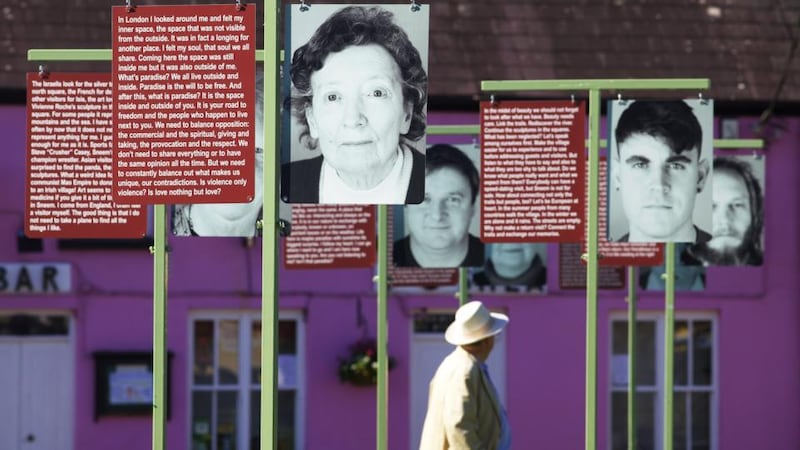Can one live in paradise? That's the question underlying an exhibition devised by Jochen Gerz, a German artist who happens to live in Sneem, Co Kerry.
"Visitors often come and look around and say, 'You're in paradise here.' But they are just here for a few hours or a few days," he says. Here in Paradise turns its attention to some of those who are living and working in "paradise".
The exhibition occupies Sneem’s two public squares, north and south. It was opened by the Minister for Arts, Jimmy Deenihan, with the French and German ambassadors, Jean-Pierre Thebault and Eckard Lübkemeyer, in attendance. That, Gerz says, is a rare enough occurrence in Ireland. Both embassies have supported the exhibition, as has Kerry County Council.

Gerz is originally from Berlin, and he lived in Paris for a lengthy period before moving to Kerry in 2007. He has worked on a succession of collaborative art projects throughout Europe, including one in Ballymun in Dublin.
These often involve large numbers of participants, and invite people to engage with ideas relating to collective memory, community and political possibility.
Under the auspices of the Tidy Towns committee, Gerz canvassed for full-time residents of Sneem – his neighbours – to participate. “We hoped for 20, and in the end we had to stop at 40.” He interviewed the participants one by one, at a leisurely pace, over coffee or tea, putting the same three questions to each.
Three wishes
The questions were a version of Aladdin’s three wishes; the wishes were in relation to Cul Fadda – a ghost estate in Sneem – to Ireland and to Europe. Every person was asked what they would wish for each.
Gerz was surprised that people were so forthcoming, and that they had such nuanced and definite views. “I thought they would have strong opinions on Cul Fadda,” he says, because it’s been controversial in the town. But he expected that Europe would be something of an abstraction for them.
The priorities were more or less reversed.
On the whole, people were pragmatic, or wryly philosophical, about the ghost estate, but thought a lot about Europe and what it might or should be.
“Everyone knows where the Celtic Tiger has gone,” as Gerz puts it, and everyone is focused on the future but also wondering about the past. After six years of relentless debate, we’re all economists now, however reluctantly. But Gerz says he believes the crisis has prompted people to reflect more deeply on the kind of world they want to live in.
One recurrent sentiment is that the selfishness of the Celtic Tiger damaged, perhaps permanently, the traditional warmth of our social relationships and communal responsibility. Rather than regretting the loss of financial wealth, people regret what was lost in pursuit of that wealth.
“The question about Cul Fadda was a way of asking: who would you want as your neighbour? Who do you want to come and live here?”
A blow-in himself, Gerz was surprised to find that so too is a significant proportion of the full-time population of Sneem. “Blow-ins come with agendas. Those agendas might be useful or they might be disturbing for the local people. They can provoke defensive reactions.”
He expected that more women than men would come forward, but the gender balance was fairly equal, and he expected more local than blow-in participants.
“But the blow-ins see themselves as part of this community and they had no hesitation in taking part.”
Another German-born Co Kerry resident, photographer Peter Zoeller, made portraits of the 40 participants. Edited sections of their responses to the questions on the three wishes are displayed on panels next to their portrait images.
The face you see next to the text is not the person who uttered the words. By redistributing the responses, Gerz is emphasising the fact that these diverse personalities and opinions all make up a community. He sees each person as symbolically minding the opinion of another. “The idea of being a keeper of the other, of taking responsibility for the other, is very important,” he says.
He is enthusiastic about the Constitutional Convention and President Michael D Higgins’s ethics initiative. “His attempt to get a national conversation going is very positive.”
Gerz sees it as very much in keeping with his own belief in an aesthetics of production, not consumption. It is up to people to shape their culture, not passively accept what others decide.
Tourist trail
Sneem is on the tourist trail, and during the summer many coaches visit. Gerz has those visitors in mind.
“This is something that they will not expect to see. For these visitors, Ireland is exceptional already. It’s like a postcard. That is what they expect – the postcard image. They are on holiday, it’s not normal life for them. But it is normal life. They respond to what they find.
“I’m trying to arrange it that what they find is not just about the past, not just the postcard, to put a question to them: can we be at peace in paradise? I hope to give them some food for thought, to prompt them to look at this place in a different way.”
Here in Paradise is at Sneem's Sculpture Gardens until September 18








